We have heard from many Gun Tests readers who have been shooting most of their life but find their chosen handguns, such as the Commander 45 ACP or midsized-frame 357 Magnum, are more difficult to control with the onset of aging and muscle loss. In the current firearms market, choosing a handgun can be a daunting proposition for anyone, but it is especially difficult for shooters with hand-strength or vision limitations.
But no one doubts the self-defense needs of older or disabled people. It is a sad fact of life that older shooters and those with some physical disability are among the most vulnerable to criminals. Often, seniors cannot run from trouble if they wanted to, and they have certain other physical limitations that affect their ability to handle weapons with vigor and accuracy. So finding a few guns suitable for these folks is an important consideration.
An older, or inexperienced, or disabled shooter still has to have a reliable sidearm, but beyond that must-have element, other factors come to the fore:
- Trigger action needs to be easier and smoother for seniors.
- The handgun should be physically easy to handle, so perhaps both the slide and the trigger need extra surface area to ensure this.
- Recoil should be minimized.
- Sighting options are important.
The older you are, maladies such as arthritis, carpal-tunnel syndrome, and injuries can come home to roost, affecting how you handle a firearm. Repetitive movement may become difficult. We talk about older shooters here as kind of a shorthand for a variety of people who may not be able to manipulate many common firearms, but the fact is, age isn’t always an indicator of disability when it comes to firearms. Our raters for this article include a young-at-heart lady with arthritic hands. Another rater is a young woman beginning her shooting career, but who is at a disadvantage, she feels, due to very small hands. Older shooters may have more difficulty racking the slide of a self loader. They may also have more difficulty pressing the trigger of a double-action revolver, which often stacks.
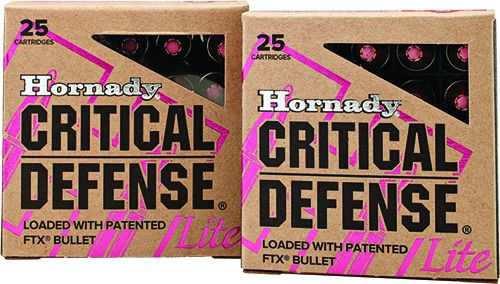
Herewith, then, we offer a number of tips for the less-abled new-gun buyer and eliminate some bad choices, focusing on home defense and general shooting. Concealed carry will take care of itself with proper holster selection. We concentrated on compromises when the chosen firearm is becoming too much to handle. We considered changing ammunition first and then caliber to maintain proficiency, but with a little less horsepower hitting the target, and also less recoil. We also considered changing grips on some of the firearms to make the choice more useful. And if the user wanted to stick with a 1911 or a snubnose revolver, we investigated what new firearm in the same class may work a bit better than the one the shooter started with.
1911-Type Handguns
One of our raters carries a Commander chambered in 45 ACP and has done so for 40 years. He has a healed bullet pucker in his leg, a knife scar on his face, a recurring limp, and arthritis, although, he says, thank God, not much of it in his hands. His present carry gun is a SIG Fastback Nightmare Carry in 45 ACP. While he feels he handles the pistol well, a range session of 50 rounds leaves his wrists sore. A few more rounds would be too much. Also, there is less range of motion in his shoulder due to stiffness, and perhaps the Commander doesn’t clear leather as quickly as it once did. He has tried using a heavier recoil spring and switching to 185-grain rather than 230-grain loads to mitigate recoil. The result has not been satisfactory, although the results were incrementally helpful. The fact is, the 45 ACP’s recoil is simply hard on the wrists.
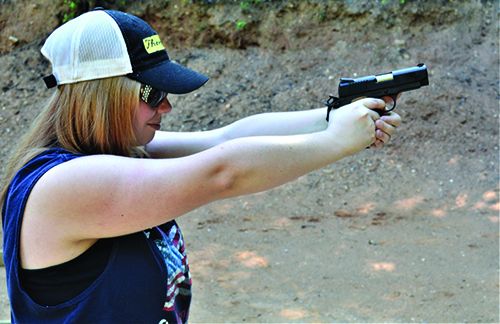
There are several Officers Model 9mm 1911 types available, and this is what we suggested. While the Ruger or Kimber may have done as well, we had a Citadel 9mm on hand. It also fit the affordable category for an older shooter on a fixed budget. The shooter had everything he liked about the 1911 — a straight-to-the-rear trigger compression, a grip safety, a slide-lock safety, a low bore axis, and even Novak sights. Magazine capacity went up one round to nine rounds total. The shooter was given 200 rounds of Winchester 115-grain FMJ ammunition and four magazines. After firing the last round to slide lock, he had a smile on his face. The shooter remarked that recoil was light and the effect was not cumulative. He could have fired more. To finish up, he fired a magazine of Winchester 9mm Luger 124-grain PDX +Ps. No problems. The Citadel neatly solves the problems of recoil.
Also, it is lighter than the SIG Commander 45, yet kicks much less. Since it is shorter, it is also easier to draw from concealed carry. While there is a lessening in power placed on the target per shot, the shooter is well armed by any standard.
Our Team Said: For 1911-style handgunners, stepping down from 45 ACP to 38 Super or 9mm Luger or other lighter-recoiling cartridges may be an easy way to keep the platform they have known and loved for decades.
Snubnose 38 Special
Another rater had carried a snubnose 38 Special Smith & Wesson 442 as a backup and occasional primary for a decade. Recoil was difficult at best, and with age had become brutal. The shooter has already uprated to a stainless-finish Smith & Wesson 638. With a duty load such as a Federal 129-grain Hydra Shock, this revolver had become inviable for this shooter. He simply could no longer handle the recoil, despite his best efforts. An overlooked difficulty we will all face as we gain our majority is thinning skin. The rater’s joints were taking a beating. To help, we added a set of Pachmayr oversize wood grips to the 638 ($35.40 from Opticsplanet.com). This made a great difference. The shooter felt his recoil tolerance had doubled, although 20 rounds of +P 38 Specials was still a limit for meaningful practice. We also recommended a standard-pressure loading in 110 grains to reduce recoil, such as the Hornady 110 -grain FTX ($21/20 rounds from AmmunitionDepot.com). The two changes, larger grips to spread out recoil and a lighter carry load, made the snubnose 38 viable for this user for many more years. While wound ballistics may suffer, shot placement might make up for the deficit.
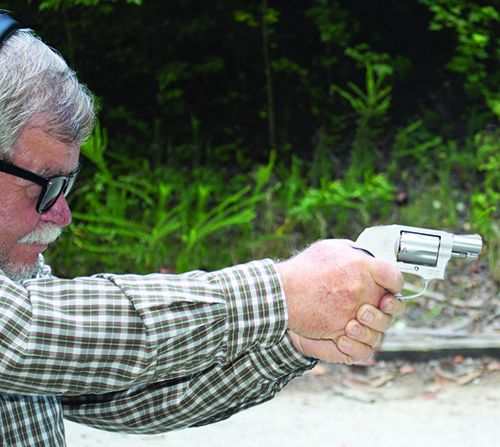
We went a bit further in exploring the 38 Special snubnose. As one rater noted, senior shooters are not slaves to fashion. They may wear baggy and loose-fitting attire. For many who prefer the snubnose 38 Special, there are larger six-shot revolvers that perform well. We provided a Colt Cobra stainless-steel 2-inch-barrel revolver to the senior and let him fire this revolver extensively. Firing first with Black Hills Ammunition 38 Special 148-grain wadcutters ($33.32/50 from TargetsportsUSA.com), the shooter found the piece much easier to control than the smaller J-frame. Then he fired Winchester 125-grain Silvertip +Ps ($35/50 from SGAammo.com) and found the Colt Cobra was much easier to use well than the J-frame. He said the Cobra was as easy to use as a 4-inch-barrel revolver on most points.
Our Team Said: Senior shooters should avoid J-frame 38- Special-size revolvers if they are able to conceal larger handguns. Clearly, for home defense, the difference in size isn’t important. The D-frame Colt wheelguns are a much better choice. Even if stoked with lighter loads, the slightly larger size offers excellent protection.
The 44 Special: A Far Out Replacement That Works
A lot of older shooters know and love the Smith & Wesson Model 13, a medium-frame revolver chambered for the 357 Magnum cartridge. But as time wore on, the original grips on one owner’s gun were eating his hands up, along with the 125-grain JHP Magnum ammo — a very effective load but among the most difficult to control. This shooter did not believe in small groups on the target, but instead wanted a solid hit in the right place. Another point on seniors — their minds are often made up on some things, and while we may disagree, they aren’t often wrong.
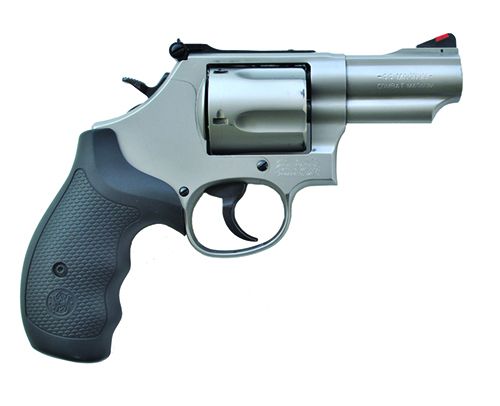
To ameliorate the owner’s troubles with his M13, we added a set of Ahrends grips ($80 from AhrendsGripsUSA.com). This helped a great deal in comparison to the original Magna-type grips. However, the greatest advantage was in switching to 38 Special ammunition. Truth be told, the majority of Magnums issued to peace officers a generation or more ago were loaded with 38 +P ammunition rather than full-strength 357s. We used the Hornady FTX. With these loads, the user was happy with firing the revolver.
There were other problems, however. The user felt that he could no longer conceal the 4-inch K-frame due to back problems. And he was not really pleased with 38 Special’s wound potential. Another rater came up with a solution that was lighter, more compact, and satisfied the user’s feelings about wound potential.
Some modern revolvers have a heavy trigger action. No getting around that. The Smith & Wesson L-frame often has a smooth trigger, and a 2.75-inch-barrel Model 69 in 44 Magnum we had on hand was at least as smooth as the old-timer’s Model 13. When we measured the trigger action on the Lyman electronic trigger-pull gauge, the L-frame was actually lighter on the trigger than the well-used Model 13.
The Hogue factory grip was quite comfortable on the L-frame Model 69, which is lighter than the Model 13 by a tad, and the M69 revolver is controllable. Also, the price isn’t bad ($714 new from TombstoneTactical.com), and the short barrel and round butt make it easier to conceal.
But wait, you say — a senior needs less, not more, recoil and the Model 69 is a 44 Magnum. The solution is to load it with 44 Special ammunition, which gives this five shooter a potent and powerful load. The Hornady 180-grain XTP ($19.50/20 from SportsmansGuide.com) breaks 980 fps from the Model 69. The power factor used to calculate recoil comes out to 172. The 125-grain 357 Magnum 125-grain JHP at 1400 fps gets a power-factor rating of 175. (Actual velocity of 125-grain Magnum loads in a 4-inch barrel may run 1370 fps to 1480 fps.) While the difference in recoil is slight by calculation, in actual firing, the 44 Special is much more pleasant to fire due to diminished muzzle blast. Also, there are considerably lighter loads in 44 Special, as light as 780 fps, that use the 0.429-inch-wide bullet. The Magnum may use 14 grains of slow-burning powder, while the 44 Special uses 5 to 8 grains of relatively fast-burning powder. Recoil seems more modest, and muzzle blast certainly is. The sights are the greatest single improvement. Aging eyes and a small groove in the top strap are not a good match. The Model 69’s high-visibility sights are an excellent choice.
Our Team Said: When choosing a suitable firearm for an elder, finding the right mix of gun size and power can be intricate. Bigger and slower might mean more controllable than smaller and snappier, in terms of recoil.
Three Specific Recommendations
Up to this point, we had worked with shooters who had adopted handguns that were giving them difficulty as the shooters encountered problems that came with age. Less recoil tolerance and less muscle mass to carry heavy handguns were among the issues. Next we began to explore the best handguns for seniors without prior experience, and also those who may have diminished visual acuity. The goal was to find a handgun that was easy to rack and make ready and easy to use well. Here are a few specific choices.
Bond Arms Bullpup 9 9mm Luger, $842
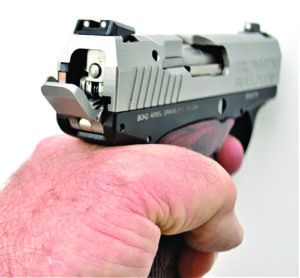
In a previous test, the Bond Arms Bullpup received high marks based on several factors. The rotating-barrel design helps mitigate 9mm recoil. The smooth double-action trigger isn’t difficult to manage. The pistol is easily concealed. The Alien Gear holster selected kept the pistol at the proper angle for an easy draw without difficulty. But one of the greatest advantages of the pistol is its easy racking. This is quite simply the easiest full-power handgun to rack we have tested. This is due to the roller-bearing smooth rotating barrel. There is no recoil spring, only a small slide return spring. The pistol is reliable.
Our Team Said: This is an excellent choice if hand-strength issues hold you back. Some of the drawbacks related to standard design handguns are not as important when a senior’s comfort is considered.
CZ P10 S Optics Ready 95170 9mm Luger, $577
We next considered what may be the best compact striker-fired polymer-frame handgun. Many are available, affordable, and reliable. We did not compare the CZ P10 S Optics Ready to other handguns in the usual Gun Tests manner yet, but we looked at it in a one-off test for seniors. It did very well.
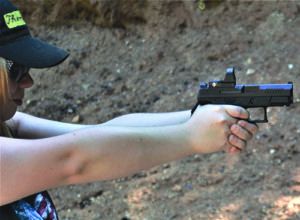
The CZ P10 S comes with several drilled and tapped plates for popular optics. The pistol was tested first with iron sights. The P10 S subcompact is slightly larger than the Glock 26. Most raters felt this makes for an easier handgun to use well. The magazines hold 12 cartridges. Firing Winchester USA 115-grain FMJs, our older shooters and our volunteer with tiny hands found the pistol very well suited to all-round shooting chores. The forward cocking serrations give the user plenty of leverage in racking the slide. The trigger is pleasant enough to use well. The handgun doesn’t stress the shooter. We mounted a Leupold Pro Point ($400 from OpticsPlanet.com) on the CZ P10 S. The result was a fast-handling pistol that even those with limited vision find useful. The CZ P10 S also features a rail for a combat light. We added the TruGlo combat light, $76, which also provides a laser. The light and laser may be used in tandem or independently.
Our Team Said: With the dot sight, laser, and light, the modest recoil and weight of the 9mm CZ P10 S is a great choice for seniors. We will wait to give it a letter grade when we’re able to shoot it head to head with other similar handguns, but we’re confident recommending it if you or someone you know needs a handgun immediately.
SIG P229 RX 9mm Luger, $1250
A number of older shooters prefer a double-action-first-shot handgun. They are leery of the new striker-fired guns and do not like cocked-and-locked carry. This is understandable, especially for home defense. The double-action-first-shot handgun may not perform as well on a combat course, but the overall handling and balance are attractive to many. Unlike the CZ P10 S, the P229 does not have grip inserts to morph the handgun to the shooters hand and the P229 also has a longer trigger span. Just the same, we find the P229RX to be an excellent senior’s choice. The pistol is as smooth and useful as any, with a double-action trigger pull of 12 pounds. The 4.2-pound single-action trigger is especially crisp. The pistol is supplied from the factory with a Romeo 1 red dot. The sight activates when the handgun is moved and cuts off on its own after a few minutes of non-movement.
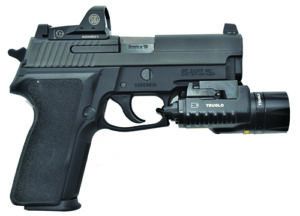
The SIG P229 RX was fired with the Winchester FMJ loads on hand. The raters felt the ergonomics were excellent, and the piece fit most hands well. Those used to a double-action handgun thought it a very good choice. However, our shooter with small hands could not reach the trigger.
Our Team Said: A senior used to the P220 45 ACP, but who has trouble coping with recoil, would find the SIG P229 RX in 9mm to be a godsend.
Other Considerations
As we mentioned, the older shooter carrying a Commander 45 downsized to a pistol he may control more easily. But he also was having difficulty with the magazine carrier, which he carried on the left side. (He is right handed.) The shoulder was simply a bit stiffer with age. By moving the magazine carrier to the right side in the appendix position, the older gentleman is able to reach to the magazine pouch, draw and reload. He has re-trained to this and doesn’t skip a beat. While not as fast as the straight-to-the-rear magazine draw in theory, in reality this draw is faster for this individual. Thinking outside the box is beneficial to older shooters, and perhaps younger shooters as well.
Written and photographed by Gun Tests staff.


























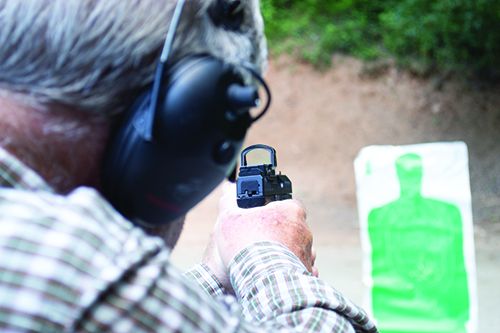

Todd:
Possibly, you already answered my question of yesterday. Maybe a nice sized sidearm in 44 Special; why couldn’t I have gotten there? Fixated on that damned 9mm on spray the neighborhood mode, I guess.
How do you compare the easy racking of the Bond Arms Bullpup 9 with S&W Shield EZ 9mm
As one of the “old timers”, I found that my 1911 is a bit much to shoot after several magazines. While I found that a S&W 638 and the 110 gr Hornady loads are easier to shot, the “airweight” 638 is too light to shoot a lot, even with the 110 gr loads, The S&W 3″ model 60, in Stainless Steel, has enough extra weight to dampen recoil. I also swapped out factory grips for the CT 305 grips, as the larger Laser grip adds ease of pointing at your target. A 3″ SS revolver with properly sized grips, is my choice for us “old timers”. Found CHARTER ARMS “Bulldog” size frames are also nice in either .357 or .44 spl,
Note – I also have an “ACTION JACK” cocking aid, in 9mm, as racking a slide is an issue with old hands. No slide to rack is another plus for a revolver.
As a 73 yr old, I carry my S&W M60 3” full under lug in 38 special. At 23 ounces it absorbs +P ammo very well, and with lead wad cutter target loads, it is very accurate and is my trail gun.
Not to sound partial towards S&W, but the S&W EZ 380 and 9 mm were especially designed for seniors for easy operation. It was disappointing Todd Woodard didn’t mention neither of these two firearms.
I’m a bit disappointed as the article doesn’t address eyesight issues us older folks have. I can’t really make out my sights clearly anymore. Hoped this article would speak to options.
Laser grips and Truglo TFX sights on any Glock 19 size gun would be perfect for anyone.
That size greatly reduces recoil and muzzle flip.
Even bad eyes can see those sights and especially the red or green dot laser.
Good article but slightly surprised that you didn’t mention any of the tip up barrel guns like the Beretta 86 in .380 or the smaller Tomcat in .32. They take away the need to work the slide to load and can be thumb cocked to negate the double action trigger. An older lady that suffers from arthritis tried one and found it to be the answer for her for concealed carry. She just couldn’t handle the trigger on her revolver. Just a thought.
Eyesight is another common issue with older folks. As I got older I began to loose my near distance vision, and so like many I wear glasses with progressive lenses. When looking through the main part of the lens I was having trouble focusing on the front sight at typical eye to front sight distances. I can bring the front sight into focus by rocking my head back to look through the bottom part of the lens, but that’s definitely not a recipe for fast shooting!
I decided to try a red dot sight to help with that problem. Since I have a few Sig DA/SA pistols, I wanted to stay with that type of platform. I ended up going a similar route to the P229 RX recommended above, but chose to splurge on a P229 RX Legion in 9mm. I have found it much easier to shoot with the red dot sight with my old eyeballs.
One thing worth mentioning for folks transitioning to a red dot sight is that it will take some practice drawing from the holster to be able to consistently and quickly pick up the red dot, so plan to spend some time working on a fast, consistent draw.
I am a 71 old shooter with psoriatic arthritis, disc problems in my back and neck, and numerous other ailments. I was quite pleased with my Colt Commander .45 and full size Sig 1911. Both were excellent and I didn’t have any problems with either handgun. But as accurate as those two handguns were, when I shot my 9 mm CZ 75B and especially my CZ 75B Compact I was amazed at how accurate and comfortable they were to shoot. My latest purchases include Glock 42 and 43. When I put the Pearce +1 mag extension, I was unable to retract the slide on either gun until I downloaded 1 round. So I guess I’ll continue with my EDC 26/27 or 19/23. At some point in time, I can see myself switching over to CZs for EDC requirements.